
Eric Clapton, wearing a crocheted “100% Birgitta” jacket by Birgitta Bjerke, performs with John Lennon during “The Rolling Stones’ Rock and Roll Circus,” December 11, 1968. (Photo by Jeff Hochberg/Getty Images) (detail)
On December 11, 1968, Eric Clapton stepped onto a low stage inside Intertel (V.T.R. Services) Studio north of London to play a few tunes with John Lennon and Keith Richards; the occasion was the taping of “The Rolling Stones Rock and Roll Circus” for the BBC. At the time, Clapton was the most revered electric guitarist in rock, even amid the incendiary ascendancy of Jimi Hendrix. A few weeks earlier, Clapton had performed his last two shows as a member of Cream at the prestigious Royal Albert Hall, and by the summer of 1969, he would team up with Steve Winwood of Traffic to form a “supergroup” called Blind Faith.
“I never had any money, so when everyone decided to go to the clubs, I went home and crocheted in my room.”
Normally, none of this would have anything to do with crochet, but on that particular December day, Clapton was wearing a brightly colored, predominantly orange crocheted jacket, in which grids of traditional granny squares on the garment’s front, back, and cuffs were paired with bold stripes of alternating colors circling up the sleeves; Clapton’s red tennis shoes and cherry-red Gibson ES-335 completed his ensemble.
Handmade for him by a 27-year-old Stockholm native named Birgitta Bjerke—who had arrived in London from New York via Athens, and sold her fashions under the label “100% Birgitta”—Clapton’s jacket reflected the anything-goes fashion ethos of London’s trendy King’s Road. That’s where Bjerke worked, hung out, and was introduced to the city’s music and fashion scenes by another Swede, Ulla Larsson, who dressed some of the biggest names in British rock from a vintage-clothing stall she managed in the Chelsea Antique Market, across the street from Carlyle Square.

Birgitta Bjerke in her London flat working on the Eric Clapton jacket. Photo by Jan Öqvist.
“It wasn’t a store per se,” Bjerke tells me over the phone, “more like a booth. It was like being in an Aladdin’s cave draped in magnificent textiles. It was fabulous.”
In those days, King’s Road was the place to be. “On Saturday afternoon,” Bjerke continues, “it was like a fashion parade. You dressed up to the max. A few years earlier, the fashion scene had been on Carnaby Street, but by the time I arrived in London in 1967, King’s Road was it. Ulla was fantastic,” Bjerke adds. “She took me under her wing.”
Bjerke would leave a colorful mark on her adoptive community—as well as a satellite contingent on the Spanish island of Ibiza—by virtue of her skill with crochet and fearless sense of style. “I made my own clothes when I was young, and designed for Oleg Cassini and crocheted for Paraphernalia when I lived in New York,” Bjerke says. “I was a fashion doll from day one.” In addition to the jacket for Clapton, Bjerke made crocheted garments for reggae superstar Jimmy Cliff, for whom she also painted an album cover.

Crocheted coats made for Roger Daltrey (left) and his wife, Heather, from 1970 and 1971. Photographed by Bjerke in 2009 at “100% Birgitta: The Fine Art of Revolutionary Crochet” at the Center of Southwest Studies at Fort Lewis College in Durango, Colorado.
Two showstoppers from her London days are the coats she crocheted for Roger Daltrey of The Who and his then-girlfriend and future wife, Heather Taylor, who had been the subject of Jimi Hendrix’s “Foxy Lady.” Unlike the Clapton jacket, which was fairly traditional except for its hue and the audacity of turning old-timey blanket crochet into clothing in 1968, the Daltrey pieces were more free-form, composed of overlapping circles of pinks, purples, and greens for Heather, and almost Tibetan racetracks of shaded blues and other hues for Roger.
“It was supposed to be long enough to drape over a white horse that he was going to ride on stage,” Bjerke remembers of the Daltrey coat. “It was a very trippy piece of art, but I don’t think he ever wore it except when he tried it on. [See update below, courtesy of Fenn.] ‘Oh,’ he said, ‘I look like a right proper poof.’ I must say, in terms of Roger, it didn’t match his personality. He was much more of a macho man, but I used commissions like that one to see how far out I could go with my art.”
In addition to rock stars, Bjerke’s London circle included the Australian artists Martin Sharp and Richard Neville, who, in 1967, launched a London version of their Sydney art, music, fashion, and counterculture magazine called Oz. Another influential person from that period was Nigel Waymouth, who, in 1966, had opened an art-and-fashion boutique called Granny Takes a Trip with his girlfriend, Sheila Cohen, just down the street from the Chelsea Antique Market. By 1967, Waymouth had teamed up with Michael English to design even trippier rock posters under the moniker Hapshash and the Coloured Coat for the UFO Club in London, where Pink Floyd performed often enough to be considered the house band.

Bjerke’s sketchbook from the late 1960s features a page with Robert Whitaker’s photograph of artist Martin Sharp paired with a Bjerke drawing of the exterior of The Pheasantry on King’s Road.
Through her friendship with Beatles photographer Robert Whitaker—who had gained infamy in 1966 when he photographed the hitherto clean-cut mop tops at his studio just off King’s Road for their controversial “butcher” album cover for the U.S. release of “Yesterday and Today”—Bjerke met The Fool, who were the soul of the new Beatles store. Marijke Koger of The Fool asked her to crochet for the store, and Bjerke got as far as making some wooly ties when the enterprise folded.
At the time of the Clapton commission, Bjerke was living at a friend’s place off Kensington High Street. “It was kitty-corner to the Baghdad House, which was a downstairs after-hours joint where everybody smoked hash, essentially. I’m sure we ate and drank there,” she says, “but I seem to remember everybody mostly just smoking and hanging out.”

Another of Bjerke’s drawings of Martin Sharp’s top-floor flat at The Pheasantry on King’s Road. For a while, an Australian filmmaker and painter named Philippe Mora lived there, as did Clapton.
A quick word about drugs: Although Bjerke definitely enjoyed the occasional puff on the communal hash pipe, she was “frightened” by the “heroin and Dormidina contingent,” as she calls them. “I was so against drugs,” she says. “I never even took LSD. I didn’t dare because my mind is pretty far out already—I didn’t think I’d ever come back.”
Her friend Jan Öqvist, another refugee from Sweden, who had arrived in London in 1968 at the impressionable age of 18, was even more circumspect. “She smoked from time to time,” Öqvist says of Bjerke, “but I didn’t even do that. I’m probably the only person in history who has passed a joint from Mick Jagger to Eric Clapton without taking a hit.”
Öqvist would end up playing a supporting role in the creation of the Clapton jacket, beginning with a 1968 photograph he snapped of Bjerke working on the garment. “I never had any money,” Bjerke explains, “so when everyone decided to go to the clubs, I went home and crocheted in my room.” Wearing flowers in her hair and a crocheted halter top of her own design and construction, Bjerke is captured by Öqvist doing just that, arranging the granny squares that would make up the front and back of the Clapton jacket.

Jan Öqvist in 1968, wearing Bjerke’s Clapton jacket, with Vern Lambert, one of the owners of the Chelsea Antique Market store where Ulla Larsson introduced Bjerke to many future clients.
As the jacket took shape, Öqvist also served as its living, breathing mannequin. “We were almost the same size,” he says of Clapton, “so I was the dummy.” Later, when Clapton was still touring with Cream and the jacket was finished, Bjerke gave it several road tests. Öqvist wore it, of course, as did a friend of Bjerke’s named Stephanie Spinner, who was in London from New York while editing a book for Dell Publishing called Rock Is Beautiful: An Anthology of American Lyrics, 1953–1968.
“Mia saw my stuff and said, ‘I’ve got to have it! I need this and this and this and this, and all the bathing suits.”
Despite not being able to afford the lifestyle of her famous friends, Bjerke moved easily in the upper echelons of the British rock world, in part because she was so unfazed by it all. “I was never a groupie,” she says flatly. “After I met Eric in London for the first time, I saw him again but didn’t recognize him because he had permed his hair. He said, ‘How many times do I have to introduce myself to you?’ The truth is, I was shy. I had a flamboyant look, but I was incredibly shy because I didn’t feel like I had much to offer. So I hid behind my crochet.” In turn, that singular focus drew British rock royalty to Bjerke. “I was allowed to be part of that world,” she says, “because of my art.”
According to Öqvist, there may have been other reasons. “She was a joyous person to be around,” he says. “She had a good spirit and was never stagnant.” As for her “flamboyant look,” “Birgitta had a unique style when it came to clothing and dressing,” he says, “and not just in the things she made.” That willingness to flaunt it like a rock star must have been very appealing to, well, rock stars.

Stephanie Spinner, wearing the Clapton jacket, with Birgitta Bjerke at Bob and Pearl’s sandwich shop in the Chelsea Antique Market overlooking King’s Road, 1968.
At some point, Bjerke’s art caught the eye of Mia Fonssagrives, who was married to French fashion designer Louis Féraud. Fonssagrives had just opened a boutique in Paris with Vicky Tiel—underwritten in part by Elizabeth Taylor—called Mia and Vicky. “I was sitting in the Chelsea Antique Market,” Bjerke remembers. “Ulla was always the star there. I was basically allowed to hang out in the background, behind the draperies, if you will, while she took care of Mick Jagger, or whoever.”
Birgitta Bjerke’s presence in Ulla Larsson’s shop highlights the perennial problem of the vintage-clothing trade—inventory, and where to get it. One of the most reliable sources was Portobello Road, where, in the 1960s, any number of vendors were selling choice pieces that had been hanging in the closets of Londoners, often for generations. There were full-length, fully embroidered, Art Deco beaded dresses from the 1920s and ’30s, as well as vintage velvet pieces and authentic military jackets, all of which sold briskly at stalls and in shops along Portobello Road.

The garments based on these illustrations from Bjerke’s sketchbook made their debut in 1969 at the Mia and Vicky boutique in Paris.
Vern Lambert, who was one of the owners of the stall where Ulla Larsson worked, had a knack for finding clothes at prices low enough to allow for a markup once they arrived on King’s Road. “Vern was smart, and a fabulous designer of pieces made from the old stuff that he and his partner, Adrian Emmerton, picked up on Portobello Road,” Bjerke recalls. “Jimi Hendrix’s silk velvet pants? That was Vern.”
Jan Öqvist also remembers the nexus between Portobello and King’s Roads. “Clothes from Portobello Road were sold through the Chelsea Antique Market by Ulla. Sometimes Birgitta mended and fixed them up. She was very good at that.”

Birgitta Bjerke crochet on the runway for Mia and Vicky, Paris, 1969. (Photo by KEYSTONE-FRANCE/Gamma-Rapho via Getty Images)
In fact, Bjerke’s facility with a needle and thread, her keen sense of style, and especially her passion for crochet, proved at times an asset for Larsson’s boutique at the Chelsea Antique Market. “Ulla could only sell what she had in the store,” Öqvist continues, “but Birgitta could manufacture new things. Handmade clothing could be personalized,” he adds, “so it was considered equally as good as old velvet. A custom-made crochet piece was very special.”
On the day Mia Fonssagrives walked into Larsson’s shop, Bjerke was wearing one of her crocheted “hand dresses,” in which a pair of crocheted hands appeared to be palming her breasts. A few of Bjerke’s other pieces, including a cartoonishly crocheted bikini, were also within Fonssagrives’ line of sight.

Bjerke’s crochet bikini was so provocative, the model hired by Mia and Vicky in 1969 was instructed to wear black leotards underneath. (Photo by KEYSTONE-FRANCE/Gamma-Rapho via Getty Images)
“Mia saw my stuff and said, ‘I’ve got to have it! I need this and this and this and this, and all the bathing suits.’ I was given a week,” Bjerke remembers, “maybe two, to get everything together before it was time to go down to Paris for their fashion show. In the end, they put black dance leotards on the model—top to bottom, with long sleeves—under the bathing suit,” she recalls with a sigh.
The Mia and Vicky fashion show led to the first of two projects with Fonssagrives’s husband, Louis Féraud. “I designed and made everything, and got $200 for the whole job, plus a plane ticket. That was the most money I had ever seen. I thought I was rich.” Thanks, no doubt, to its new connection to Féraud, Bjerke’s work caught the attention of Vogue magazine, which photographed one of the hottest models of the era, Penelope Tree, posing on the streets of Paris in brightly colored “100% Birgitta,” even though the article credits Louis Féraud as the designer.
By the end of 1969, Bjerke had left London for the island of Ibiza, whose reputation in those days was as the only free-spirited enclave within dictator Francisco Franco’s Spain. “I had met someone in Paris who was driving to Barcelona to see her boyfriend,” Bjerke says. “She invited me to keep her company on the drive, so I did. Once we got there, she suggested I take the boat to Ibiza for the day before we drove back to Paris. That’s how I discovered Ibiza. I went straight back to London, packed my stuff, and moved.”

Model Penelope Tree on the streets of Paris in a crocheted dress by Birgitta Bjerke—Vogue credited Louis Féraud as the designer. (Photo by John Cowan/Conde Nast via Getty Images)
Once in Ibiza, Bjerke met people like photographer Karl Ferris, who had shot psychedelic album covers for Cream, Donovan, and Jimi Hendrix, but had recently left London with his wife, Anke, to raise their child. Later, Bjerke also crossed paths with a young American named Tim Martin, who arrived by motorcycle—a 441cc, single-cylinder BSA—from London.
“I went from living in a little suburb north of Seattle to London and then Ibiza,” Martin recalls. “I was not quite 18 years old, and here were all these incredibly beautiful women in exotic clothes. It was like being in the heart of the hippie wonder world.”
Martin can’t remember exactly when he met Bjerke, but his description of their first encounter sounds a lot like the woman Öqvist photographed in London while she was working on the Clapton jacket, only transported to Ibiza and attired for the sun. “She was wearing this itsy-bitsy bikini she’d crocheted,” Martin recalls. “She was sitting on a little blanket next to one or two of those classic Ibiza straw baskets—hers were held together with patches and filled with yarn, her sketchbook, camera, and crochet gear. She was always working on a commission.”

“Hippie Royalty on the Rocks,” by Karl Ferris, circa 1970. That’s Bjerke in the center. Click to enlarge.
In those days, Ibiza was populated by about 200 or 300 expatriates. “Most were living alternative lifestyles, to put it mildly,” Martin says. “There was a couple who were art forgers, but hanging out was everybody’s main profession. It was a very small, intimate community. Even though Franco was still in power in the rest of Spain, in Ibiza the government seemed to let go a little bit.” So, while there were beaches where people bathed in the nude, you could be fined 1,000 pesetas if you were caught.
In the morning, people who weren’t sleeping off whatever hedonistic debauch had taken place the night before went to Cafe Montesol for café con leche and maybe a slice or two of toast. In the afternoon, after spending much of the day at a favorite beach called Las Salinas, many of the same crowd would cool off with an iced horchata, a lemonade, or perhaps an ice cream at the Horchateria. “You moved from one spot to the next,” Bjerke says. “You went to the beach, then you went home and made love, and later on in the afternoon it was time for a drink.” After the sun went down, many headed to a club called La Tierra, “our nightly hangout,” Bjerke calls it, run by yet another expat, Arlene Kaufman.

Bonnie Bramlett wearing the Clapton jacket on the back cover of Clapton’s 1970 solo debut. Photo by Barry Feinstein.
Amid all this, Bjerke stuck to her crochet. “I was still dirt poor,” she says, “but I could live off the vests and hats I sold, what Martin Sharp used to call my ‘wooly wonders.’ As usual, I was very much a bird of paradise, on the outside looking in.”
The impact of Bjerke’s one-year stay on Ibiza can be seen in a Karl Ferris photograph taken in the spring of 1970. In it, we see Bjerke standing proudly in the middle of the frame, wearing a long, rainbow coat and surrounded by a few dozen of her Ibiza friends clad in “100% Birgitta” crochet. There are hats and halters, pants and jackets, even a few swimsuits—for the record, Ferris’ wife, Anke, and their baby are in the front row, third from the left. “I got all those friends together at 11 in the morning to dress in woolens,” she laughs. “I don’t know how that was possible, but I did it.”
By the summer of 1970, Bjerke had returned to the U.K. to attend The Bath Festival of Blues and Progressive Music, June 27-29, and Isle of Wight, August 26-31. “A whole gang of us went,” she remembers. “Music was our food.”

The Clapton jacket made its last public appearance, again on Bonnie Bramlett, on the cover of the last Delaney and Bonnie album, released in 1972. The jacket is the only part of the black-and-white photograph that has been hand tinted.
Bjerke’s Clapton jacket was also on the move. In early 1970, when Clapton was working on his first solo album in Los Angeles, Barry Feinstein photographed the guitarist sitting alongside the dozen or more musicians who backed him up. One of the faces in that illustrious crowd—which included Leon Russell, Bobby Keys, and Rita Coolidge—was Bonnie Bramlett, whose husband, Delaney, produced Clapton’s solo debut. In Feinstein’s photograph, which became the Clapton album’s back cover, Bonnie Bramlett is seen sitting on a ladder wearing Bjerke’s Clapton jacket.
Two years later, in 1972, Bramlett was in the jacket again, this time on the cover of Delaney & Bonnie’s last album, “D & B Together.” Because complete footage of “The Rolling Stones Rock and Roll Circus” was not released until 1996, many people inclined to think about such things—a small cohort, to be sure—assumed the crocheted jacket must have belonged to Bramlett all along, having seen her in it on two album covers, but having never watched the video of Clapton wearing it first in 1968. It’s likely that Clapton, who toured with Delaney & Bonnie in late 1969 and early 1970, simply gave his Bjerke crocheted jacket to Bramlett at some point for whatever reason, although the precise circumstances of the exchange have yet to surface publicly.

The “Pioneer,” bedspread, as seen in 2017 at the De Young Museum’s “Summer of Love” exhibition in San Francisco. Photo by Rusty Blazenhoff.
After London and Ibiza, Bjerke was ready for another change, so she headed west to San Francisco, where, once again, she moved easily in local rock circles, particularly those that intersected with the Grateful Dead’s (Bjerke had met one of the band’s managers, Danny Rifkin, in London). Friends and clients in the first half of the 1970s included Susila Ziegler Kreutzmann, who was married at the time to the Dead’s drummer, Billy, and for whom she crocheted a number of pieces, including a jacket that transported a hippie tie-dye aesthetic to crochet. For Frankie Azzara, who was going out with the group’s singer and rhythm guitarist, Bob Weir, Bjerke made a kaleidoscopic bedspread called “Pioneer” that took her two years to finish—by the time she was done with this masterpiece, Frankie and Bobby had gone their separate ways.

Two of Bjerke’s crochet portraits. Top: Queen Elizabeth II on the day of her coronation. Above: Meher Baba.
San Francisco turned out to be the place where Bjerke really came into her own as an artist. “Even today, after 40 years in New Mexico, I would say I’m a Bay Area artist, because that’s where I did most of my work,” she says. Now, in addition to commissions for her increasingly complex crocheted coats, suits, wedding dresses, bedspreads, and the like, Bjerke was using crochet to create small paintings and larger murals, as she calls them. Examples include a portrait from 1971 of the Indian guru Meher Baba, as well as a crocheted depiction from 1974 of Queen Elizabeth II, as if she were posing for Bjerke on the day of her coronation.
“You could say I paint with yarn,” she explains. “Take, for example, the red curtain around the portrait of the Queen. If that had been a watercolor, I could have just faded the color with water to create shading, shadow, and depth on a flat surface. But with yarn, I had to use every color of red I could find, from darkest to lightest, in order to achieve the same effect.” That meant Bjerke was always on the lookout for new shades of yarn in every color of the rainbow. “I became a yarn addict.”
By the middle of the 1970s, Bjerke was back in Sweden, this time to live for a few years on an island in the Baltic Sea called Gotland. “It has 93 medieval churches, all completed before the year 1300,” she says of Sweden’s largest island. In 1978, she produced her second and last collection for Louis Féraud, and then, in 1980, she was off again, this time to New Mexico, where she lives to this day when she isn’t restoring an old farmstead on Gotland.

The jacket Bjerke made for Susila Ziegler Kreutzmann transported a hippie tie-dye aesthetic to crochet.
It was in New Mexico that Bjerke began a second career in the film industry. Her big break came in 1982, when she landed the job of costume designer on “Paris, Texas,” which was directed by independent filmmaker Wim Wenders and starred Nastassja Kinski, for whom Bjerke eventually found the film’s iconic pink Angora sweater.
“That was knitted by a girl named Susie Hart,” Bjerke says. “I had picked out a white one, but when I had it dry cleaned, it shrunk to the size of a postage stamp. That’s when I borrowed Susie’s fabulous pink Angora for Nastassja.” The image of Kinski in that sweater became such a signature for the film, it was used on a number of movie posters.
Bjerke would work with about a dozen independent filmmakers over the next two decades as their costume designer. Most gave her such tiny budgets that she could only shop for costumes at thrift stores. She also took supporting costume and wardrobe gigs on films as varied as “Lust in the Dust,” “Dances with Wolves,” and a 2013 miniseries called “Longmire.”

“Hornsgatan,” named for a street in Stockholm, was begun in 1978, put away, and finished in 2008. Here, Bjerke models the knitted outfit outside her cabin in Pecos, New Mexico.
“The films I worked on were a paycheck and nothing else,” she says without a hint of remorse. “I’m glad I got the chance to work in the movies. It was a great adventure to be a part of ‘Dances with Wolves,’ and I got to create some fabulous costumes, but I was an artist first.” That’s why, between jobs on films and TV shows, Bjerke pushed herself when it came to her art—there would be no resting on the rock-and-fashion laurels of her past. “I didn’t want to be seen as some brief, 1960s accident,” she explains.
And so, Bjerke stuck to her crocheting, continuing the work she had pursued in London, Ibiza, and San Francisco, only this time her crochet was imbued with the spirit of the Southwest. Thus, her Crow jacket from 1982 or the Desert Rose ensemble from 1997 or the Adobe jacket from 2008, each of which uses motifs, tones, and even architectural references from her new home in their designs. One outfit called “Hornsgatan” bridged two of her worlds. “It’s called ‘Hornsgatan’ because that’s where I started it in 1978,” she says, referring to a street in Stockholm where a close friend had lent her a space to work. “I bagged it half completed, with all its yarn and needles, and finished it 30 years later. How? Don’t ask me; it’s in my blood, I guess. I have no patterns, I do it all straight out of my head!”

Fred Trujillo in Bjerke’s “Adobe” jacket from 2008 features the colors and architecture of her home state of New Mexico.
Bjerke also made time for exhibitions of her work, beginning in 2000 with a small solo show at the Bolinas Gallery in California. By the middle of the first decade of the 21st century, she took a break from film to organize her work, past and present, for more ambitious exhibitions. “I had quit the movies,” she says, “and spent almost two full years, 24/7, tracking down, locating, and either borrowing or buying back my own work. I’d call people and say, ‘Hi, my name is Birgitta, we met in Ibiza in 1969. I was the Swedish woman who knit.’ To my astonishment they all remembered, and most had all caringly saved the work.” Her biggest disappointment, she tells me, remains not being able to track down the pieces she made for Louis Féraud, although one imagines she’d also like to know what became of the Clapton jacket.
“I also made a fabulous bedspread for Eric,” she mentions, deepening the mystery. “It was my first one.”
Her missing work for Féraud, Clapton, and so many others notwithstanding, by 2009, Bjerke had gathered enough old and new pieces to mount a retrospective of her work titled “100% Birgitta: The Fine Art of Revolutionary Crochet” at the Center of Southwest Studies at Fort Lewis College in Durango, Colorado. During the following decade, Bjerke also participated in numerous group exhibitions at such institutions as the Victoria & Albert Museum in London, the Bellevue Arts Museum near Seattle, the Museum of Arts and Design in New York, and the De Young Museum in San Francisco.

Bjerke in New Mexico during the 2020 COVID-19 lockdown, wearing her latest creation, a cape-like coat called “Heart of Gold.”
Today, at 80, Bjerke continues to divide her time between Pecos, New Mexico, and Gotland, Sweden, and is making some of the best crochet of her career, including a stunning tour-de-force completed during the 2020 COVID-19 lockdown called Heart of Gold, which features handmade sterling-silver buttons by late local artist Bob Erickson. “I’m just a little nobody in the Pecos wilderness,” she says of her motivation to make new work. “I’m not ambitious for fame and fortune; I’m ambitious to see what else the good Lord has put in me that hasn’t materialized yet. That’s what I’m doing right now—trying to finish up.”
Nor has Bjerke retired completely from film. “I’m still working in the movies,” she says, “but not as a designer, I wouldn’t dream of that.” Instead, she’s found her niche in a corner of the costuming profession as an ager/dyer. In short, Bjerke takes new garments and gives them the patina of age, an irony that is not lost on Bjerke. “How appropriate at my age to be aging and dyeing for a living,” she says. “How wonderful!”
(All images courtesy Birgitta Bjerke unless otherwise noted.)
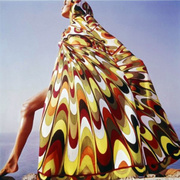
 Leading the Charge Against Casual Style, Armed With Antique Clothes and a Bike
Leading the Charge Against Casual Style, Armed With Antique Clothes and a Bike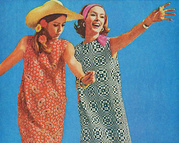
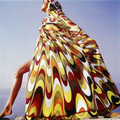 Caftan Liberation: How an Ancient Fashion Set Modern Women Free
Caftan Liberation: How an Ancient Fashion Set Modern Women Free Leading the Charge Against Casual Style, Armed With Antique Clothes and a Bike
Leading the Charge Against Casual Style, Armed With Antique Clothes and a Bike From Hospital Gowns to Paper Couture: The Unlikely Origins of '60s Disposable Dresses
From Hospital Gowns to Paper Couture: The Unlikely Origins of '60s Disposable Dresses CrochetCrochet is a type of knitting that became popular in the West during the 19…
CrochetCrochet is a type of knitting that became popular in the West during the 19…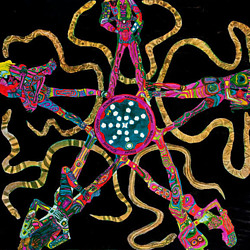 Mari Tepper: Laying it on the Line
Mari Tepper: Laying it on the Line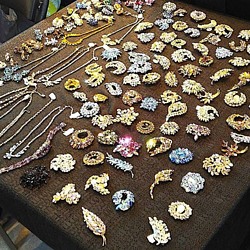 Nice Ice: Valerie Hammond on the Genteel Charm of Vintage Canadian Costume Jewelry
Nice Ice: Valerie Hammond on the Genteel Charm of Vintage Canadian Costume Jewelry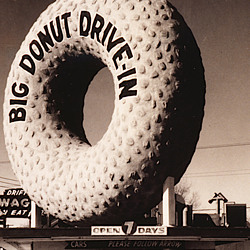 How Jim Heimann Got Crazy for California Architecture
How Jim Heimann Got Crazy for California Architecture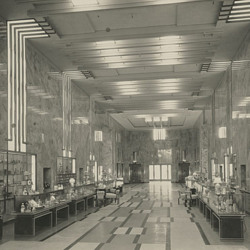 Modernist Man: Jock Peters May Be the Most Influential Architect You've Never Heard Of
Modernist Man: Jock Peters May Be the Most Influential Architect You've Never Heard Of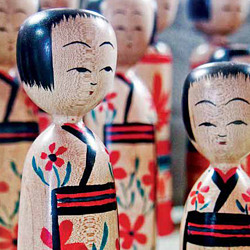 Meet Cute: Were Kokeshi Dolls the Models for Hello Kitty, Pokemon, and Be@rbrick?
Meet Cute: Were Kokeshi Dolls the Models for Hello Kitty, Pokemon, and Be@rbrick?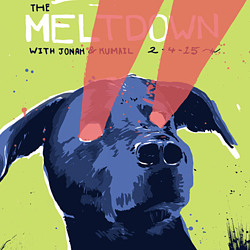 When the King of Comedy Posters Set His Surreal Sights on the World of Rock 'n' Roll
When the King of Comedy Posters Set His Surreal Sights on the World of Rock 'n' Roll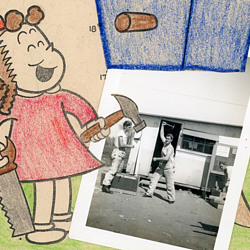 How One Artist Makes New Art From Old Coloring Books and Found Photos
How One Artist Makes New Art From Old Coloring Books and Found Photos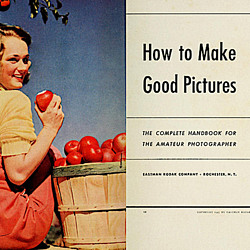 Say Cheese! How Bad Photography Has Changed Our Definition of Good Pictures
Say Cheese! How Bad Photography Has Changed Our Definition of Good Pictures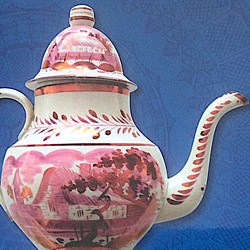 Middle Earthenware: One Family's Quest to Reclaim Its Place in British Pottery History
Middle Earthenware: One Family's Quest to Reclaim Its Place in British Pottery History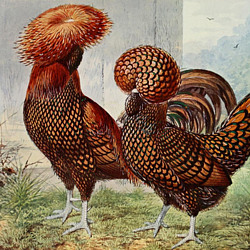 Fancy Fowl: How an Evil Sea Captain and a Beloved Queen Made the World Crave KFC
Fancy Fowl: How an Evil Sea Captain and a Beloved Queen Made the World Crave KFC
Love Roger’s sweaters. If he hugged you whilst wearing them…imagine the warmth!
I remember those London days fondly. Then, as now, Birgitta was endlessly creative, a force of nature.
Is there any way that we could buy a copy of the pattern of the jacket she made for Susila Ziegler Kreutzmann or would she be willing to share it
I read this article last year and loved it, and in a bit of a deep dive into The Who rarities lately, found a video from Top of the Pops that features Roger Daltrey in the crochet jacket mentioned!
Not sure if posting a link here will get my comment filtered, but search YouTube for “The Who, I Don’t Even Know Myself (BBC1 TOTP into 1971) video”. Poor quality video, but it looks magnificent on him even if it’s not his usual aesthetic.
Thanks Fenn! We just added the video to the article, with a credit to you. Best, Ben
Absolutely stunning work by Birgitta Bjerke.
Shows 50 years of culture and style placed on people of influence who rocked the world with music
Birgitta is a Queen of colors, style and insight with great imagination. She is a fierce warrior of art on all levels who has lived all around the world and worked her magic on over 40 films and in the closets of many lucky people. Birgitta, We applaud you, Bravo!!!
I’ve been wondering about the Clapton jacket, its history, and if there was a pattern for it for *years*! I’m so glad to’ve come across this article and learn about this wonderful artist! Thank you!
Fantastic article and i remember Bergitta as my parents owned the cafe in the chelsea antique market as seen in one of your photos